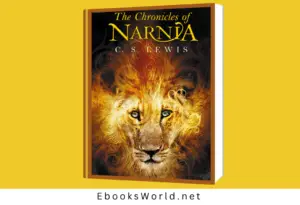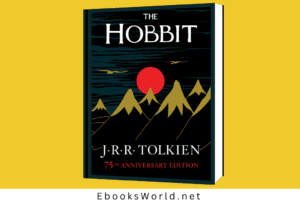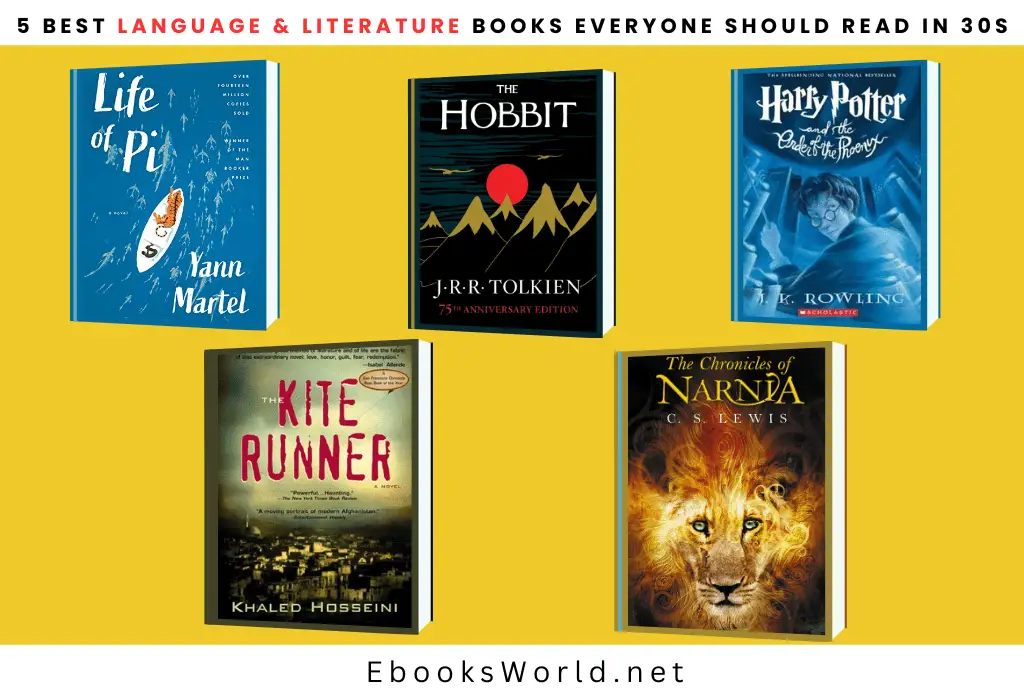The Chronicles Of Narnia

“The Chronicles of Narnia” is a series of seven high-fantasy novels written by British author C.S. Lewis. The series is considered a classic in the fantasy genre and has captivated readers of all ages since its first publication in the 1950s. The books are known for their allegorical and Christian themes, as well as their imaginative world-building and engaging storytelling.
Here’s a brief summary of each book in “The Chronicles of Narnia”:
1. The Lion, the Witch and the Wardrobe (1950): Four siblings – Peter, Susan, Edmund, and Lucy – are evacuated from war-torn London to a countryside mansion. While playing hide and seek, Lucy stumbles upon a wardrobe that leads her to the magical land of Narnia. There, she meets a faun named Mr. Tumnus and learns that Narnia is under the rule of the evil White Witch. With the help of the great lion Aslan, the siblings must unite Narnia’s creatures and break the witch’s spell.
2. Prince Caspian (1951): Years later, the Pevensie siblings return to Narnia and discover that the land has been taken over by Telmarines, who have suppressed the native Narnians. They help Prince Caspian, the rightful heir to the throne, reclaim his kingdom. With the help of Narnian creatures, including talking animals and mythical beings, they battle for Narnia’s freedom.
3. The Horse and His Boy (1954): This book follows Shasta, a young boy raised as a fisherman’s son in Calormen. He escapes and meets Bree, a talking horse who reveals his true identity as a Narnian prince. Together with another runaway, Aravis, and her talking horse, they journey to Narnia, encountering adventures and challenges along the way.
4. The Silver Chair (1953): Eustace Scrubb, who appeared in the previous book, and his schoolmate Jill Pole are sent to Narnia to rescue Prince Rilian, the missing son of King Caspian. Guided by the wise Marshwiggle Puddleglum, they travel underground to the land of the evil Queen of the Underland. Their quest is to break the enchantment and free Prince Rilian.
5. The Voyage of the Dawn Treader (1952): Edmund, Lucy, and their cousin Eustace return to Narnia through a magical painting aboard the ship Dawn Treader. They join King Caspian on a voyage to explore the uncharted eastern seas of Narnia. Along the way, they encounter islands with various magical creatures and challenges, ultimately seeking the seven lost Lords of Narnia.
6. The Magician’s Nephew (1955): This book serves as a prequel to the series, exploring the creation of Narnia by Aslan. It follows two children, Digory and Polly, who inadvertently travel between different worlds using magic rings created by Digory’s uncle. They witness the birth of Narnia and inadvertently bring evil into the world, which sets the stage for future events.
7. The Last Battle (1956): In the final book, Narnia is on the brink of destruction as a false Aslan deceives many of its inhabitants. A final battle between good and evil ensues, marking the end of Narnia. The story explores themes of faith, redemption, and the afterlife as characters face the ultimate challenges.
Each book in “The Chronicles of Narnia” offers a unique adventure within the same enchanting universe, highlighting the characters’ growth, bravery, and moral dilemmas. The series as a whole delves into timeless themes of loyalty, sacrifice, and the battle between good and evil.
Harry Potter

The “Harry Potter” series is a globally popular fantasy book series written by British author J.K. Rowling. The series consists of seven novels that follow the life and adventures of a young wizard named Harry Potter and his friends as they navigate the magical world and confront various challenges, including the dark wizard Lord Voldemort. The books are known for their intricate world-building, well-developed characters, and themes of friendship, courage, and the struggle between good and evil.
Here’s a brief summary of each book in the “Harry Potter” series:
1. Harry Potter and the Sorcerer’s Stone (Philosopher’s Stone in some regions) (1997): The series begins with young Harry Potter discovering that he is a wizard on his eleventh birthday. He learns about his past, including the death of his parents at the hands of the dark wizard Voldemort. Harry starts attending Hogwarts School of Witchcraft and Wizardry, where he makes friends, learns about magic, and uncovers a plot involving the Sorcerer’s Stone, which grants immortality.
2. Harry Potter and the Chamber of Secrets (1998): In Harry’s second year at Hogwarts, strange things start happening, including messages warning of danger and students being petrified. Harry discovers that the Chamber of Secrets has been opened, releasing a creature that threatens the students. With the help of his friends, he uncovers the truth behind the Chamber’s secrets and battles the dark forces at play.
3. Harry Potter and the Prisoner of Azkaban (1999): In his third year, Harry learns that Sirius Black, a dangerous criminal, has escaped from the wizarding prison Azkaban and is believed to be after him. As Harry unravels the mystery surrounding his parents’ death and his connection to Sirius, he encounters creatures called Dementors, gains new insights into his past, and discovers the truth about his family.
4. Harry Potter and the Goblet of Fire (2000): In his fourth year, Harry unexpectedly becomes a competitor in the Triwizard Tournament, a dangerous magical competition. Despite being underage, he must face deadly challenges and confront his own fears. The tournament takes a tragic turn as Voldemort’s followers plot to resurrect their master and return him to power.
5. Harry Potter and the Order of the Phoenix (2003): In this darker installment, Harry returns to Hogwarts to find that the Ministry of Magic denies Voldemort’s return, causing frustration and distrust among wizards. Harry and his friends form “Dumbledore’s Army” to resist and learn defensive magic. Harry experiences visions of Voldemort’s actions and history, leading to a climactic battle in the Department of Mysteries.
6. Harry Potter and the Half-Blood Prince (2005): As Harry begins his sixth year, he delves into Voldemort’s past through a series of memories, uncovering the dark wizard’s Horcruxes, objects containing fragments of his soul. The book focuses on the growing threat of Voldemort’s return and Harry’s quest to defeat him. Tragedy strikes as a beloved character dies.
7. Harry Potter and the Deathly Hallows (2007): In the final installment, Harry, Ron, and Hermione embark on a quest to locate and destroy Voldemort’s Horcruxes, which are the key to his immortality. Their journey takes them on a dangerous and emotional path, culminating in the climactic Battle of Hogwarts. The series concludes with the ultimate confrontation between Harry and Voldemort.
The “Harry Potter” series is celebrated for its magical setting, relatable characters, and exploration of themes such as friendship, love, sacrifice, and the complexities of good and evil. The books have inspired a massive fan base, film adaptations, spin-off works, and continue to be cherished by readers of all ages around the world.
The Hobbit & The Lord Of The Rings

Certainly! Both “The Hobbit” and “The Lord of the Rings” are high-fantasy novels written by British author J.R.R. Tolkien. They are set in the fictional world of Middle-earth and are renowned for their rich world-building, complex characters, and epic storytelling.
Here’s a summary of each book:
The Hobbit: “The Hobbit” (1937) follows the adventures of Bilbo Baggins, a content and unadventurous hobbit, who is unexpectedly thrust into a grand quest. Gandalf the wizard and a group of dwarves led by Thorin Oakenshield recruit Bilbo as a “burglar” to help them reclaim their homeland, the Lonely Mountain, from the fearsome dragon Smaug. Throughout their journey, Bilbo encounters trolls, goblins, spiders, elves, and other magical creatures. He also acquires the One Ring, a powerful artifact that plays a significant role in “The Lord of the Rings” series. The story combines adventure, humor, and Bilbo’s personal growth as he evolves from a timid hobbit into a brave and resourceful hero.
The Lord of the Rings: “The Lord of the Rings” is a trilogy consisting of three novels: “The Fellowship of the Ring” (1954), “The Two Towers” (1954), and “The Return of the King” (1955).
1. The Fellowship of the Ring: The series begins with Frodo Baggins, Bilbo’s nephew, inheriting the One Ring from his uncle. He is entrusted with the task of destroying the ring to prevent the dark lord Sauron from regaining his full power. Frodo is joined by a fellowship of various characters, including Gandalf, Aragorn, Legolas, Gimli, Boromir, and others. They set out on a perilous journey to Mordor, the only place where the ring can be destroyed in the fires of Mount Doom. Along the way, they face challenges, battles, and personal struggles against the corrupting influence of the ring.
2. The Two Towers: The fellowship becomes separated, and the narrative follows multiple storylines. Frodo and his loyal friend Sam continue their journey toward Mordor, encountering Gollum, a creature consumed by the power of the ring. Meanwhile, the remaining members of the fellowship defend against the forces of Sauron. Aragorn, Legolas, and Gimli aid the kingdom of Rohan, while Merry and Pippin befriend Treebeard and the Ents.
3. The Return of the King: The final installment sees the climax of the storylines. The peoples of Middle-earth unite in the battle against Sauron’s armies. Frodo and Sam reach Mount Doom, but the ring’s temptation nearly overcomes Frodo. Gollum’s intervention leads to the ring’s destruction, causing Sauron’s downfall. The series concludes with the restoration of peace, the crowning of Aragorn as King of Gondor, and the departure of the elves from Middle-earth.
“The Lord of the Rings” explores themes of heroism, friendship, sacrifice, the struggle between good and evil, and the human condition. It’s a sprawling epic that has captivated readers for decades and has been adapted into successful film adaptations as well.
The Kite Runner

“The Kite Runner” is a novel written by Khaled Hosseini and published in 2003. The story is set against the backdrop of Afghanistan’s tumultuous history, spanning from the 1970s to the early 2000s. The novel explores themes of friendship, betrayal, redemption, and the impact of personal choices on individuals and their relationships. Here’s a summary of the book:
The novel is narrated by Amir, a young Afghan boy living in Kabul in the 1970s. Amir’s closest friend is Hassan, the son of his father’s servant. Despite their social differences, Amir and Hassan share a deep bond, largely formed through their mutual love for kite flying. The two participate in the annual kite-fighting tournament, where Amir hopes to win his father’s approval and love.
One fateful day, during the kite-fighting competition, Amir witnesses a traumatic incident involving Hassan. Overwhelmed by guilt and shame, Amir distances himself from Hassan and betrays their friendship. The incident has a lasting impact on both boys and leads to a rupture in their relationship.
As Afghanistan undergoes political turmoil with the Soviet invasion, Amir and his father, Baba, flee to the United States. They settle in California and build a new life, but Amir struggles with the memories of his past and his feelings of guilt over what happened to Hassan.
Years later, Amir receives a call from an old family friend, Rahim Khan, who urges him to return to Afghanistan. Rahim Khan reveals a secret that prompts Amir to confront his past and seek redemption. Amir travels back to a war-torn Afghanistan, where he discovers the truth about Hassan’s fate and the sacrifices he made for Amir.
Amir’s journey leads him to confront his own shortcomings and seek a way to make amends for his past mistakes. He discovers the importance of facing the truth, making difficult choices, and trying to set things right. Along the way, he encounters the effects of decades of conflict and displacement on the Afghan people.
Ultimately, Amir takes on the responsibility of caring for Hassan’s orphaned son, Sohrab, and strives to provide the love and protection he once denied Hassan. In the process, Amir finds a chance at redemption and begins to rebuild the broken pieces of his life and the lives of those he loves.
“The Kite Runner” delves into complex themes of guilt, forgiveness, and the lasting impact of traumatic events. Through Amir’s personal journey, the novel highlights the power of storytelling, the enduring bonds of friendship, and the potential for redemption even in the face of past mistakes.
Life Of Pi

“Life of Pi” is a novel written by Yann Martel and published in 2001. The novel tells the extraordinary story of a young Indian boy named Piscine Molitor Patel, often referred to as Pi, who survives a shipwreck and is stranded in the Pacific Ocean on a lifeboat with a Bengal tiger named Richard Parker. The book explores themes of survival, faith, storytelling, and the complexity of human-animal relationships. Here’s a summary of the book:
The story is framed as a narrative being told by an adult Pi to a writer looking for an interesting story. Pi begins by recounting his early life in India, where his family owns a zoo. Pi is curious and spiritually inclined, practicing Hinduism, Christianity, and Islam simultaneously.
Pi’s life takes a dramatic turn when his family decides to move to Canada, taking their animals with them on a cargo ship. Tragedy strikes when the ship sinks in the middle of the Pacific Ocean due to a storm. Pi miraculously survives by finding himself on a lifeboat with a zebra, a hyena, an orangutan, and the Bengal tiger, Richard Parker.
As days turn into weeks, Pi struggles to survive on the lifeboat with limited supplies. The hyena kills the zebra and orangutan, leaving Pi alone with the tiger. In order to assert his dominance and survival, Pi establishes a precarious relationship with Richard Parker, using his knowledge of animal behavior and his resourcefulness to stay alive.
Pi’s daily routine involves rationing food, collecting rainwater, and trying to fend off the tiger’s attacks. Despite the perilous situation, Pi maintains his sanity by keeping a sense of routine and establishing a connection with the tiger through training and mutual understanding.
After more than 200 days at sea, the lifeboat reaches a mysterious island that initially appears to offer food and shelter. However, the island has a sinister secret—it is carnivorous and devours animals that venture onto its shores during the night. Pi and Richard Parker quickly leave the island to continue their journey on the lifeboat.
Finally, the lifeboat reaches the shores of Mexico. Exhausted, malnourished, and near death, Pi is rescued by a group of people. Richard Parker, however, leaves the boat and disappears into the jungle without looking back.
Pi’s incredible survival story is met with skepticism by the authorities and insurance representatives. In a twist, Pi offers an alternate version of his story, replacing the animals with human characters. He describes how the animal story allowed him to cope with the horrors of his ordeal and the darker aspects of human nature.
Ultimately, the novel raises questions about the nature of truth, the power of storytelling, and the human capacity for resilience and imagination. “Life of Pi” is a thought-provoking exploration of faith, survival, and the ways in which individuals construct their own narratives to make sense of their experiences.







